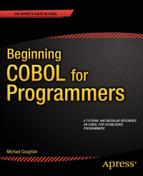Preface
It seems strange to be writing a book on COBOL so many years after its death was first predicted. Indeed, COBOL has had such a low profile in recent years that you might be forgiven for thinking that it had all but disappeared. The nature of our industry is such that the new and exciting always gets more airplay than the secure, the accurate, and the reliable. But while Java, C#, Ruby, Python, and Objective C have dominated our consciousness in recent times, in the background billions of lines of COBOL code have quietly gone about supporting the mission-critical applications that make the world work.
Now, after many years, awareness is increasing about COBOL and the huge body of legacy COBOL code. COBOL is mentioned more and more in magazines, in trade journals, and in newspapers. Indeed, you may be reading this book because you have noticed this activity and have become curious about COBOL. You may have wondered why this supposedly dying language is attracting attention recently. The reason is simple. There is a legacy crisis just around the corner, and stakeholders are trying to do something about it.
The problem is, so many attempts to rewrite COBOL legacy systems or replace them with off-the-shelf solutions have ended in failure that custodians of legacy systems are now wary of these approaches to modernization. Migrating the COBOL codebase to take advantage of less-expensive hardware and software is now seen as a more viable, safer, and cheaper alternative to replacement. But keeping, and even growing, the COBOL codebase requires COBOL programmers—and the COBOL workforce is aging and nearing retirement. In an effort to avert the workforce crisis, legacy system stakeholders have implemented initiatives to increase the number of new COBOL programmers entering the marketplace. COBOL implementers such as IBM and Micro Focus have introduced initiatives to encourage colleges and universities around the world to teach COBOL as part of their curriculum, training companies and in-house training groups are once more starting to provide instruction in COBOL, and employers have begun to offer a number of entry-level COBOL positions.
Over the last few years, the demand for programmers has far exceeded the supply. However, as the number of students graduating from computer science courses recovers from the year 2000 downturn, the job market is likely to become more and more competitive. In such a competitive environment, and at a time when the demand for COBOL programmers is increasing, you may find it profitable to have a résumé that includes a knowledge of COBOL.
Who This Book Is For
This book is aimed at programmers familiar with other languages who are curious about COBOL or are working with COBOL legacy systems or who wish to take advantage of COBOL job opportunities. To get the most from this book, you must have some knowledge of programming. It is not an introductory programming text.
How You Should Read This Book
If you are using this book to learn to program in COBOL, rather than just dipping into it to find out how a particular construct or verb works, then you should read the book in the chapter order provided. Many chapters foreshadow or preview material that is dealt with more completely in succeeding chapters. If you read the chapters out of order, you may find the discussion confusing. However, if you wish, you may skip the first chapter, because it deals with such matters as the history of COBOL, the importance for COBOL, and the characteristics of COBOL and COBOL applications. Even if you do skip Chapter 1, you may find it rewarding to read it later. It should provide a ready source of ammunition with which to respond to any expressions of amazement that you are learning COBOL.
